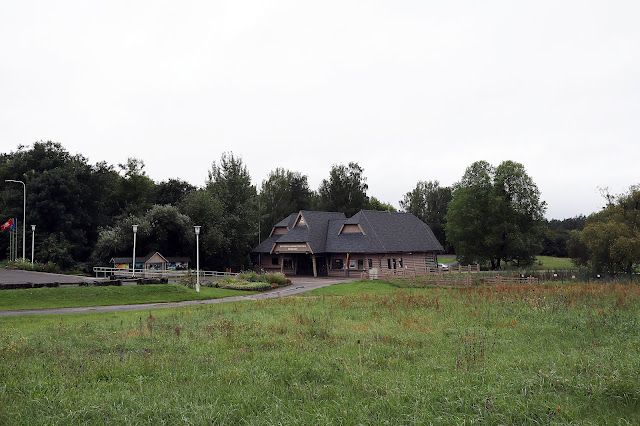Lithuania: Road Trip - Lithuania, Day 6: Exploring Kaunas and Rumšiškės
The Greek, Latin, German, Celtic, and the Slavic are one of the oldest languages in the World, but they are not even nearly as old as the Lithuanian tongue, which is the most ancient one from them all. It belongs to an Indo-European language group and of all the tongues spoken today, Lithuanian is the closest one to the ancient Sanskrit. The longest Lithuanian word is: "nebeprisikiškiakopūsteliaujantiesiems" which has 37 letters and the language is spoken by around 3 million native speakers.
We woke up in a rainy day and in the morning I volunteered to go shopping for breakfast. Since it didn't stop raining, everyone decided to stay at our apartment and watch TV, while I put on my rain jacket and started exploring Kaunas. Randomly I visited different places and on the way I picked up a few geocaches. I returned back with the supplies for lunch. Before the nightfall, Nada, Ana, Rok and me decided to visit the Lithuanian Open Air Folk Museum, Rumšiškės.
 |
| Morning activities: Nada had a therapy sessions, while Ana, Maja, Rok and Tadej had breakfast made by Tuši. |
 |
| Walk along the Neman river, that rises in central Belarus and flows through Lithuania. After 937 kilometres it drains into the Curonian Lagoon. |
 |
| Behind the Kaunas State Drama Theatre. |
 |
| Laisvės alėja - Liberty Avenue is with 1.6 kilometres the longest pedestrian street in Eastern Europe. |
 |
| Žuvusiems už Lietuvos laisvę paminklas - Monument to Those Perished for the Freedom of Lithuania was created by the sculptor Juozas Zikaras and the architect Vladimiras Dubeneckis and was unveiled on 16. October 1921, later demolished in 1949 and reconstructed in 1990. |
 |
| Vytauto Didžiojo karo muziejus - Vytautas the Great War Museum. |
 |
| One of the most famous objects in front of the Vytautas the Great War Museum are the lions, who came to Kaunas from the Astravas Manor and who guard the entrance to the museum. They were commissioned by Count Jonas Tiškevičius and cast from cast-iron in St. Petersburg in the middle of the 19th century. After the construction of the new Vytautas the Great War Museum building, Jonas Tiškevičius, the son of Count Tiškevičius, donated the lions to the Museum. |
 |
| Our girls from the van in the future? |
Courtyard Gallery is established next to the Kaunas Synagogue, among houses, which during the Inter-war period were mostly inhabited by Jewish families.
Kaunas city wall and the stairs to the Pelėdų kalnas - Owl hill.
Pelėdų kalnas - Owl hill got its name in 1924, when the fence surrounding a 3.5-hectare area was decorated with a grand total of 108 owls. The sculptures were created by Vincas Grybas (1890–1941), a student at Kaunas art school located on the very same hill.
 |
| Mood after lunch. |
 |
| The rain finally stopped and with Ana, Nada and Rok we visited Rumšiškės, a town best known for its excellent open-air ethnographic museum. |
 |
| The Open-Air Museum of Lithuania is one of the largest ethnographic open-air museums in Europe that stretches across the area of 195 ha. |
The centrepiece of the museum is a town featuring buildings from all over Lithuania typical to different time periods.
The town has all prerequisite town elements: a market square with natural stone paving, a church, an inn and houses of various craftsmen and traders engaging in pottery, weaving, amber and wood crafting.
 |
| We were the last visitors, so the town square was empty. |
The total area of 175 ha contains 140 buildings from the 18th-19th century with the restored original interiors and surroundings. This museum was established to help to preserve and research the former ways of living.
 |
| Each year the museum holds more than 15 events (Mardi Gras, Easter, Stork Day, Crafting, Work and Amusement Day, St. John’s Eve, St. Anne’s and Rye Harvest Day, Assumption of the Virgin Mary Day, Stump Burning on Christmas Eve, etc.). |
 |
| The buildings of this museum are exposed as farmsteads and all of them together represent the main ethnographic regions of Lithuania: Aukštaitija, Samogitia, Dzūkija and Suvalkija. Each has the homes, barns, granaries, stables, mills characteristic to the area. |
Inspecting the thatched roof house.
 |
| Interior of one of the houses. |
 |
| The area is quite huge, so that around 10 km of walking is required to see everything. |
 |
| Windmill. |
Caught doing another selfie.
Engineers checking the shake roof.
Another windmill.
 |
| Buying a new property? |
Towards the houses from Dzūkija, one of five ethnographic regions of Lithuania.
Nobody home, so we moved on towards the exit.
 |
| The state flag of Lithuania displays the national emblem in a banner form, flag was adopted in 2004. |
 |
| Road Trip - Lithuania, Day 6. |
- Kaunas Cultural Centre, GC3XKDB
- Pedestrian bridge, GC8TMDM
- "Lietuvos teatrui 100", GC9E3HY
- Donut - a constant, Virtual, GC7B9RD
- Vytautas the Great War Museum, Virtual, GC7B94W
- A. Žmuidzinavičiaus kūrinių ir rinkinių muziejus, GC6JZT6
- Kiemo galerija. Virtual Reward 2.0, Virtual, GC891C9
- Malūnininko bokštas, GC8VNH2
- Pelėdų kalnas, GC7GD4X
































































































